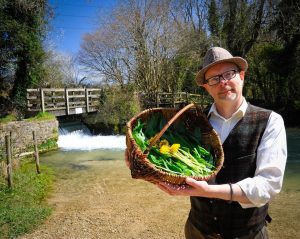It’s that time of year when we like to take a trip to the coast. Preferably somewhere fairly remote and clean with dramatic scenery. The British Isles can be very dramatic indeed outside of the holiday season and if you enjoy dramatic landscapes the coast in early spring will not disappoint. Our trip this year brought high winds and cool temperatures, so thermal base layers and parkas were the order of the day, and we managed to play in full comfort, fishing on the rocks, gathering shellfish and above all getting in the vital seaweed harvest for the coming year. The location for our stay? Glebe House in Pembrokeshire, which is a wonderful choice which I would highly recommended at any time of the year.
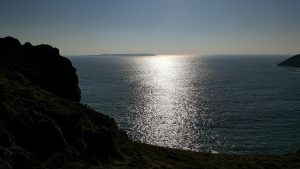
The coastal habitat supports a diverse array of foods, so we did not limit ourselves to eating seaweed for the weekend but the young tender leaves, shoots and buds of alexanders, navelwort, scurvy grass, rock samphire and sea beet were all on the menu as were a variety of shellfish. This is a time of year to celebrate the greening of things. So many flavours and textures to incorporate into stir-frys, frittatas, smoothies, delicate soups and little side-dishes of steamed spring vegetables. At this time of year the increase in abundance, now fully evident, brings hope to the heart for the year ahead and inspires us to get out and do more of what we love best – gathering our food.
Seaweeds are a very nutritious source of food. Many people in Western Europe have not tried them and do not realise just how diverse a source of food they can be. Every species found growing near to the shore around the British Isles is non-toxic*, so they are generally pretty safe to experiment with, but although some types taste GREAT when prepared in the right ways, there are also a few tastebud-shockers! It has to be said that gutweed Ulva intestinalis, purple laver Porphyra umbilicalis, serrated wrack Fucus serratus, sugar kelp Saccharina latissima, pepper dulse Osmundea pinnatifida**, dulse Palmaria palmata, caragheen Chondrus crispus, and sea sphaghetti Himanthalia elongata, are among our firm favourites. They are all well worth going out for!
* There is one toxic species in much deeper water.
**Much squealing and happy dancing from Tasch when she finds fresh pepper dulse!
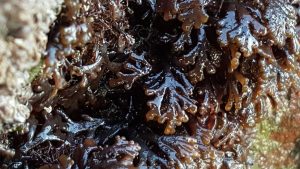
Delicious! Young pepper dulse growing from a rock – some say this is the truffle of the sea.
One of the missions for our trip was to gather, process, dry and powder enough wrack to cover our nutritional needs for a year. Wrack, like most seaweeds, is rich in iodine, which is an essential micro-nutrient for a healthy thyroid gland. Like other brown seaweeds it is an abundant source of chlorophyll (a and c) and is also rich in many other micro-nutrients, minerals and vitamins, including A, C, K, and niacin (B3). It is a good source of the polysaccharide known as fucoidan – an immune modulator which is the subject of lots of research at the moment as it shows promise as an antibacterial, antiviral, antitumor, anticoagulant, and antioxidant substance.
When one uses seaweed as a tasty concentrate in cooking, one should also be aware that it is sometimes possible to consume a little bit too much iodine from some seaweeds, and I am thinking here particularly of kelp which is super-rich in iodine. This would not be a problem with occasional eating, but if you consume a seaweed product every single day this becomes a consideration as you don’t want to overdose and block the thyroid gland altogether. Using anything with this degree of regularity generally requires a different approach. Some samples of dried kelp powder are so rich that a regular daily dose of more than a fraction of a teaspoonful could actually be an iodine overdose over time for susceptible people, but most other seaweeds contain less iodine and are much less problematic This is possibly the reason why goitres, the tell tale swelling of the throat, have always been so common among the Japanese fishing families who traditionally use kelp as a major component of their diet. The moral of this tale? A little bit of what you fancy does you good… but too much, too often and it generally ceases to be a good thing.
For the remainder of this post I shall focus on making wrack powder. Wracks come in a number of different types. Each species has its own characteristics by which it can be identified; there is knotted wrack, serrated wrack, bladder wrack, twisted wrack, channelled wrack, but turned into wrack powder they generally taste and smell pretty similar and can be used in similar ways.
Wracks are fascinating organisms, reproducing by means of mobile sperm and eggs produced in different parts of the algal body. Incredibly, the female reproductive parts actually attract swimming male sperm by secreting pheromones into the water. It should be noted that the young pale green wrack growth can be washed and diced for inclusion in salads where it gives a pleasant, vitamin A enriched, crunchiness. In Greenland wracks are traditionally used as a boiled green vegetable. They do, in fact, make good greens though it takes a fair amount of cooking to make them tender unless you use only the youngest pale green growth. Wracks are very common. Search for them in the middle intertidal zone and you will normally not be disappointed, but take care not to be greedy as they are also food for many other animals.
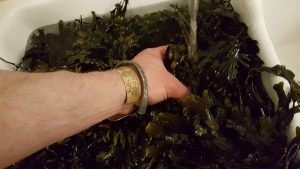
Washing wrack to remove sand and debris ready for the drying process
Once you have a few armfuls of wrack it must be washed and dried. These days it is particularly important as our seas are not as clean as they once were. As well as quite a bit of sand, my recent batch, from a pristine bay with very little human habitation, still yielded a small quantity of tell tale blue and yellow plastic flecks. You don’t want to eat these as many plastics are endocrine disruptors and some also release heavy metals as they break down. Unfortunately the inhabitants of the sea all have to eat them. I have long accepted that as a member of the species that has so tragically polluted this planet there is going to be some of this pollution in my food no matter where it comes from. Whilst I seek the cleanest food that I can find it is a reality that all food, whether wild or no, is at least to a small degree contaminated with our chemical wastes. Seaweed is not more contaminated than anything else grown in sea or soil, but it is certainly no exception either.
Drying can be accomplished on a washing line, or even over a rock on a sunny day with a good wind. Alternatively, dry your wrack by hanging near a fire, or use a dehydrator. A fast blender of the type used to make raw-food smoothies will generally be sufficient to grind the wrack to a powder providing that you process it in small quantities.
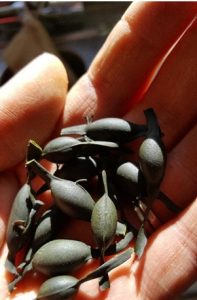
Characteristic float chambers of knotted wrack.
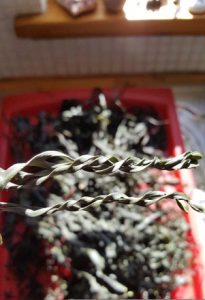
The twists of spiral wrack accentuated by drying.
The photographs below show the drying process in action and the final product! A teaspoonful of wrack powder provides an umami component to stocks and sauces whilst providing essential micronutrients, vitamins and minerals. Once the flavour is cooked-in a little it is delicious and well worth the time taken to gather and prepare.
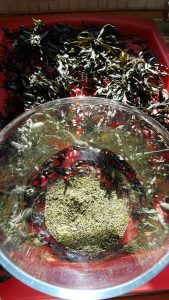
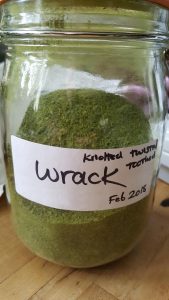
AS WITH ALL NEW FOODS, if you decide to try eating any kind of seaweed then please eat just a little at first to make sure that it agrees with you. Food allergies and intolerances can occur to just about anything!

